Composite Right/Left-Handed Leaky-Wave Antenna with Electrical Beam Scanning Using Thin-Film Ferroelectric Capacitors
Abstract
1. Introduction
2. Leaky-Wave Antenna Design
2.1. CRLH Leaky-Wave Antenna Basic Principles
2.2. CRLH Unit Cell Design
2.3. Simulation Results of CRLH Leaky-Wave Antenna
2.4. Substrate Material
2.5. Thin-film Ferroelectric Capacitors
3. CRLH LWA Prototype Characteristics
4. Conclusions
Author Contributions
Funding
Institutional Review Board Statement
Informed Consent Statement
Data Availability Statement
Conflicts of Interest
References
- Chaloun, T.; Boccia, L.; Arnieri, E.; Fischer, M.; Valenta, V.; Fonseca, N.J.; Waldschmidt, C. Electronically steerable antennas for future heterogeneous communication networks: Review and perspectives. IEEE J. Microwaves 2022, 2, 545–581. [Google Scholar] [CrossRef]
- Mittra, R.; Nasri, A.; Arya, R.K. Wide-angle scanning antennas for millimeter-wave 5G applications. Engineering 2022, 11, 60–71. [Google Scholar] [CrossRef]
- Ahmed, F.; Singh, K.; Esselle, K.P. State-of-the-Art Passive Beam-Steering Antenna Technologies: Challenges and Capabilities. IEEE Access 2023, 11, 69101–69116. [Google Scholar] [CrossRef]
- Javanbakht, N.; Syrett, B.; Amaya, R.E.; Shaker, J. A review of reconfigurable leaky-wave antennas. IEEE Access 2021, 9, 94224–94238. [Google Scholar] [CrossRef]
- Lv, H.H.; Huang, Q.L.; Hou, J.Q.; Shi, X.W. Fixed-frequency beam-steering leaky-wave antenna with switchable beam number. IEEE Antennas Wirel. Propag. Lett. 2020, 19, 2077–2081. [Google Scholar] [CrossRef]
- Wang, M.; Ma, H.F.; Zhang, H.C.; Tang, W.X.; Zhang, X.R.; Cui, T.J. Frequency-fixed beam-scanning leaky-wave antenna using electronically controllable corrugated microstrip line. IEEE Trans. Antennas Propag. 2018, 66, 4449–4457. [Google Scholar] [CrossRef]
- Zvolensky, T.; Chicherin, D.; Räisänen, A.V.; Simovski, C. Leaky-wave antenna based on micro-electromechanical systems-loaded microstrip line. IET Microwaves Antennas Propag. 2011, 5, 357–363. [Google Scholar] [CrossRef]
- Karmokar, D.K.; Guo, Y.J.; Chen, S.L.; Bird, T.S. Composite right/left-handed leaky-wave antennas for wide-angle beam scanning with flexibly chosen frequency range. IEEE Trans. Antennas Propag. 2019, 68, 100–110. [Google Scholar] [CrossRef]
- Karmokar, D.K.; Chen, S.L.; Bird, T.S.; Guo, Y.J. Single-layer multi-via loaded CRLH leaky-wave antennas for wide-angle beam scanning with consistent gain. IEEE Antennas Wirel. Propag. Lett. 2018, 18, 313–317. [Google Scholar] [CrossRef]
- Alibakhshikenari, M.; Virdee, B.S.; Azpilicueta, L.; Naser-Moghadasi, M.; Akinsolu, M.O.; See, C.H.; Liu, B.; Abd-Alhameed, R.A.; Falcone, F.; Huynen, I.; et al. A comprehensive survey of “metamaterial transmission-line based antennas: Design, challenges, and applications”. IEEE Access 2020, 8, 144778–144808. [Google Scholar] [CrossRef]
- Lim, S.; Caloz, C.; Itoh, T. Metamaterial-based electronically controlled transmission-line structure as a novel leaky-wave antenna with tunable radiation angle and beamwidth. IEEE Trans. Microw. Theory Tech. 2004, 52, 2678–2690. [Google Scholar] [CrossRef]
- Liu, P.; Yao, Z.; Zhou, J.; Yang, Z.; Kong, L.B. Small magnetic Co-doped NiZn ferrite/graphene nanocomposites and their dual-region microwave absorption performance. J. Mater. Chem. C 2016, 4, 9738–9749. [Google Scholar] [CrossRef]
- Ranga, R.; Kumar, A.; Kumari, P.; Singh, P.; Madaan, V.; Kumar, K. Ferrite application as an electrochemical sensor: A review. Mater. Charact. 2021, 178, 111269. [Google Scholar] [CrossRef]
- Mohammadi Shirkolaei, M.; Ghalibafan, J. Scannable Leaky-Wave Antenna Based on Ferrite-Blade Waveguide Operated Below the Cutoff Frequency. IEEE Trans. Magn. 2021, 57, 2800510. [Google Scholar] [CrossRef]
- Altynnikov, A.; Gagarin, A.; Tumarkin, A.; Kotel’nikov, I. Characterization of the properties of barium–strontium titanate films and controlled elements based on them in the frequency range of 1–60 GHz. Tech. Phys. Lett. 2019, 45, 540–543. [Google Scholar] [CrossRef]
- Setter, N.; Damjanovic, D.; Eng, L.; Fox, G.; Gevorgian, S.; Hong, S.; Kingon, A.; Kohlstedt, H.; Park, N.; Stephenson, G.; et al. Ferroelectric thin films: Review of materials, properties, and applications. J. Appl. Phys. 2006, 100, 051606. [Google Scholar] [CrossRef]
- Hajisaeid, E.; Deshmukh, S.; Burbine, S.J.; Keaney, E.E.; Lepont, C.; Herndon, M.; Barry, C.; Mead, J.; Akyurtlu, A. Printed planar tunable composite right/left-handed leaky-wave antenna based on a tunable polymer-BST substrate. Microw. Opt. Technol. Lett. 2021, 63, 626–637. [Google Scholar] [CrossRef]
- Tumarkin, A.; Razumov, S.; Gagarin, A.; Altynnikov, A.; Mikhailov, A.; Platonov, R.; Kotelnikov, I.; Kozyrev, A.; Butler, J.E. Ferroelectric varactor on diamond for elevated power microwave applications. IEEE Electron Device Lett. 2016, 37, 762–765. [Google Scholar] [CrossRef]
- Gaidukov, M.; Gagarin, A.; Kozyrev, A.; Razumov, S.; Tumarkin, A.; Altynnikov, A. Microwave losses in metal-ferroelectric-metal thin-film capacitors. Tech. Phys. Lett. 2008, 34, 565–567. [Google Scholar] [CrossRef]
- Kuylenstierna, D.; Vorobiev, A.; Linnér, P.; Gevorgian, S. Composite right/left handed transmission line phase shifter using ferroelectric varactors. IEEE Microw. Wirel. Compon. Lett. 2006, 16, 167–169. [Google Scholar] [CrossRef]
- Ramezanpour, S.; Nikmehr, S.; Pourziad, A. Modelling of a BST-0.5 IDC with application in electronically scanned CRLH LWA. Prog. Electromagn. Res. B 2011, 32, 39–56. [Google Scholar] [CrossRef][Green Version]
- Lai, A.; Itoh, T.; Caloz, C. Composite right/left-handed transmission line metamaterials. IEEE Microw. Mag. 2004, 5, 34–50. [Google Scholar] [CrossRef]
- Yang, W.; Peng, Z.; Ren, J.; Gao, J.; Zhai, G. Composite Right/Left-Handed Leaky-Wave Antenna with High Scanning Rate. IEEE Antennas Wirel. Propag. Lett. 2022, 21, 2522–2526. [Google Scholar] [CrossRef]
- Ueda, T.; Kamino, M.; Kondo, T.; Itoh, T. Two-Degree-of-Freedom Control of Field Distribution on Nonreciprocal Metamaterial-Line Resonators and Its Applications to Polarization-Plane-Rotation and Beam- Scanning Leaky-Wave Antennas. IEEE Trans. Microw. Theory Tech. 2022, 70, 50–61. [Google Scholar] [CrossRef]
- Sarkar, A.; Lim, S. Half-mode SIW based tunable CRLH leaky-wave antenna for emerging 5G applications. In Proceedings of the 2019 8th Asia-Pacific Conference on Antennas and Propagation (APCAP), Incheon, Republic of Korea, 4–7 August 2019; IEEE: Piscataway, NJ, USA, 2019; pp. 436–437. [Google Scholar]
- Çelenk, E.; Türker Tokan, N. Frequency Scanning Conformal Sensor Based on SIW Metamaterial Antenna. IEEE Sens. J. 2021, 21, 16015–16023. [Google Scholar] [CrossRef]
- Katehi, P.; Alexopoulos, N. On the effect of substrate thickness and permittivity on printed circuit dipole properties. IEEE Trans. Antennas Propag. 1983, 31, 34–39. [Google Scholar] [CrossRef]
- Ye, Y.; Guo, T.L. Hole metallisation technology for microwave printed circuit board. Trans. IMF 2009, 87, 217–220. [Google Scholar] [CrossRef]
- Fuscaldo, W.; Maita, F.; Maiolo, L.; Beccherelli, R.; Zografopoulos, D.C. Broadband Dielectric Characterization of High-Permittivity Rogers Substrates via Terahertz Time-Domain Spectroscopy in Reflection Mode. Appl. Sci. 2022, 12, 8259. [Google Scholar] [CrossRef]
- Kozyrev, A.; Komlev, A.; Sosunov, A.; Altynnikov, A.; Platonov, R. Analysis of the Nicolson-Ross-Weir Method for Characterizing the Electromagnetic Properties of Engineered Materials. J. Russ. Univ. Radioelectron. 2023, 26, 16–24. [Google Scholar] [CrossRef]
- Han, K.; Zhou, J.; Li, Q.; Shen, J.; Qi, Y.; Yao, X.; Chen, W. Effect of filler structure on the dielectric and thermal properties of SiO2/PTFE composites. J. Mater. Sci. Mater. Electron. 2020, 31, 9196–9202. [Google Scholar] [CrossRef]
- Luukkonen, O.; Maslovski, S.I.; Tretyakov, S.A. A Stepwise Nicolson–Ross–Weir-Based Material Parameter Extraction Method. IEEE Antennas Wirel. Propag. Lett. 2011, 10, 1295–1298. [Google Scholar] [CrossRef]
- Rothwell, E.J.; Frasch, J.L.; Ellison, S.M.; Chahal, P.; Ouedraogo, R.O. Analysis of the Nicolson-Ross-Weir Method for Characterizing the Electromagnetic Properties of Engineered Materials. Prog. Electromagn. Res. 2016, 157, 31–47. [Google Scholar] [CrossRef]
- Razumov, S.V.; Tumarkin, A.V.; Gaidukov, M.M.; Gagarin, A.G.; Kozyrev, A.B.; Vendik, O.G.; Ivanov, A.V.; Buslov, O.U.; Keys, V.N.; Sengupta, L.C.; et al. Characterization of quality of BaxSr1−xTiO3 thin film by the commutation quality factor measured at microwaves. Appl. Phys. Lett. 2002, 81, 1675–1677. [Google Scholar] [CrossRef]
- Chen, S.L.; Karmokar, D.K.; Li, Z.; Qin, P.Y.; Ziolkowski, R.W.; Guo, Y.J. Continuous Beam Scanning at a Fixed Frequency with a Composite Right-/Left-Handed Leaky-Wave Antenna Operating Over a Wide Frequency Band. IEEE Trans. Antennas Propag. 2019, 67, 7272–7284. [Google Scholar] [CrossRef]
- Lim, S.; Caloz, C.; Itoh, T. Electronically scanned composite right/left handed microstrip leaky-wave antenna. IEEE Microw. Wirel. Compon. Lett. 2004, 14, 277–279. [Google Scholar] [CrossRef]
- Li, Z.; Cui, W.; Liu, R.; Zhang, K.; Liang, W.; Wang, M.; Fan, C.; Zheng, H.; Li, E. Investigation of Leaky-Wave Antenna with Stable Wide Beam-Scanning Characteristic. IEEE Trans. Antennas Propag. 2022, 70, 240–249. [Google Scholar] [CrossRef]
- Fu, J.h.; Li, A.; Chen, W.; Lv, B.; Wang, Z.; Li, P.; Wu, Q. An Electrically Controlled CRLH-Inspired Circularly Polarized Leaky-Wave Antenna. IEEE Antennas Wirel. Propag. Lett. 2017, 16, 760–763. [Google Scholar] [CrossRef]
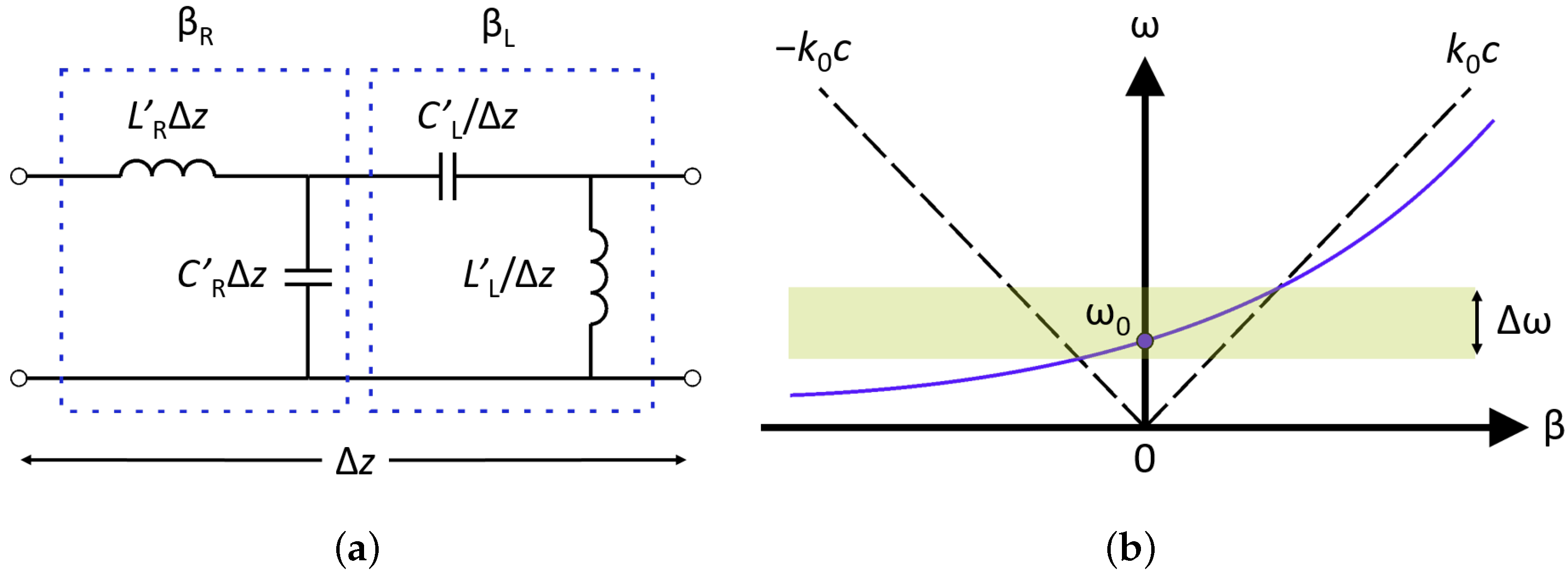

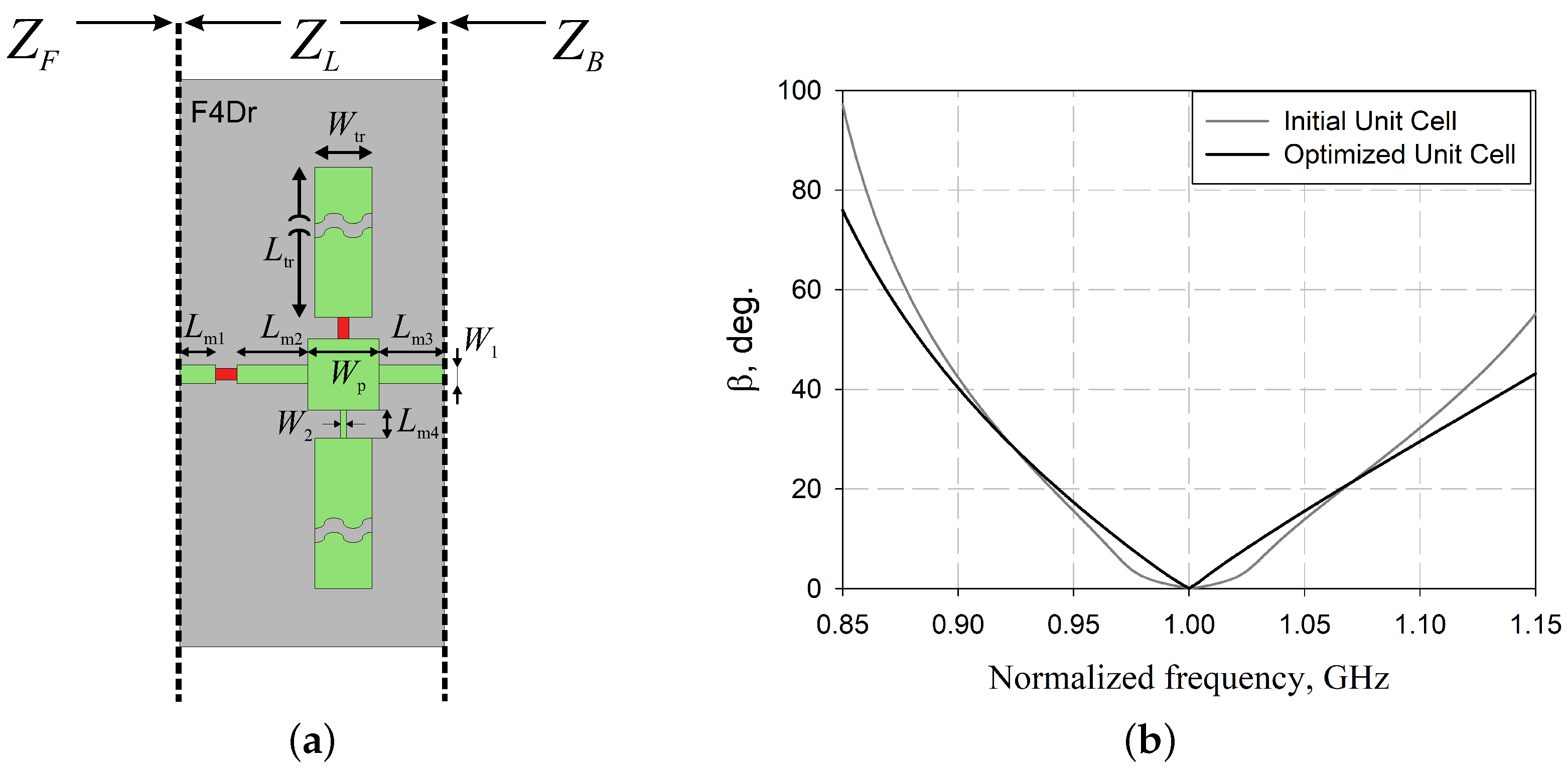
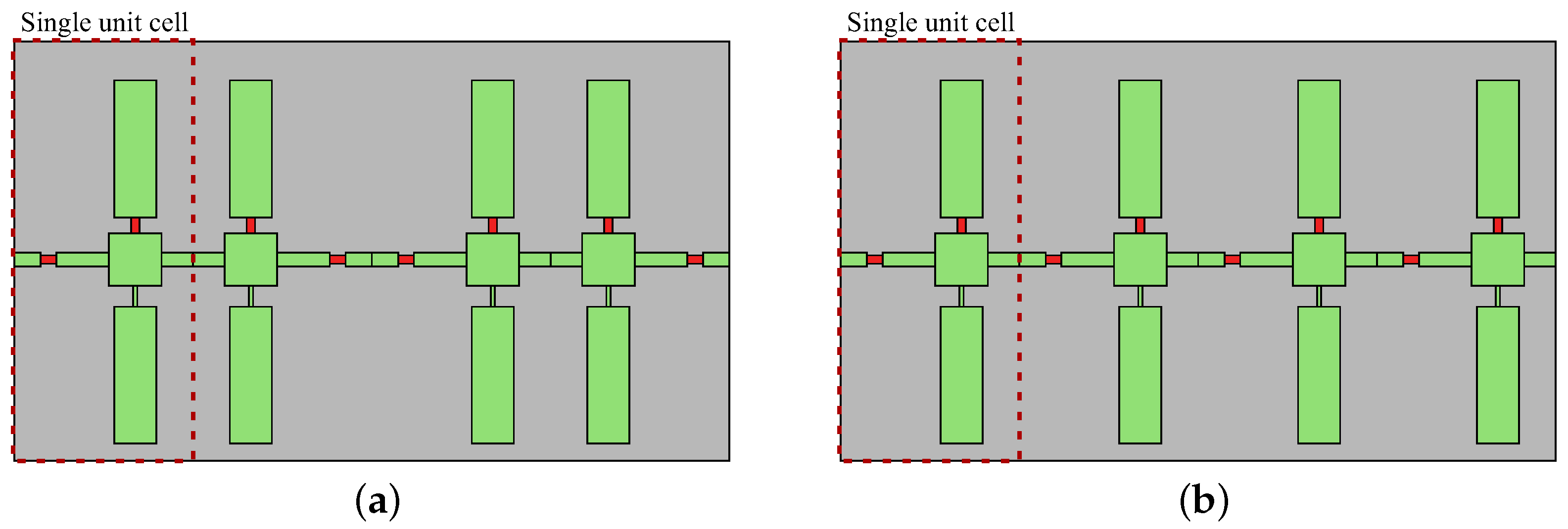
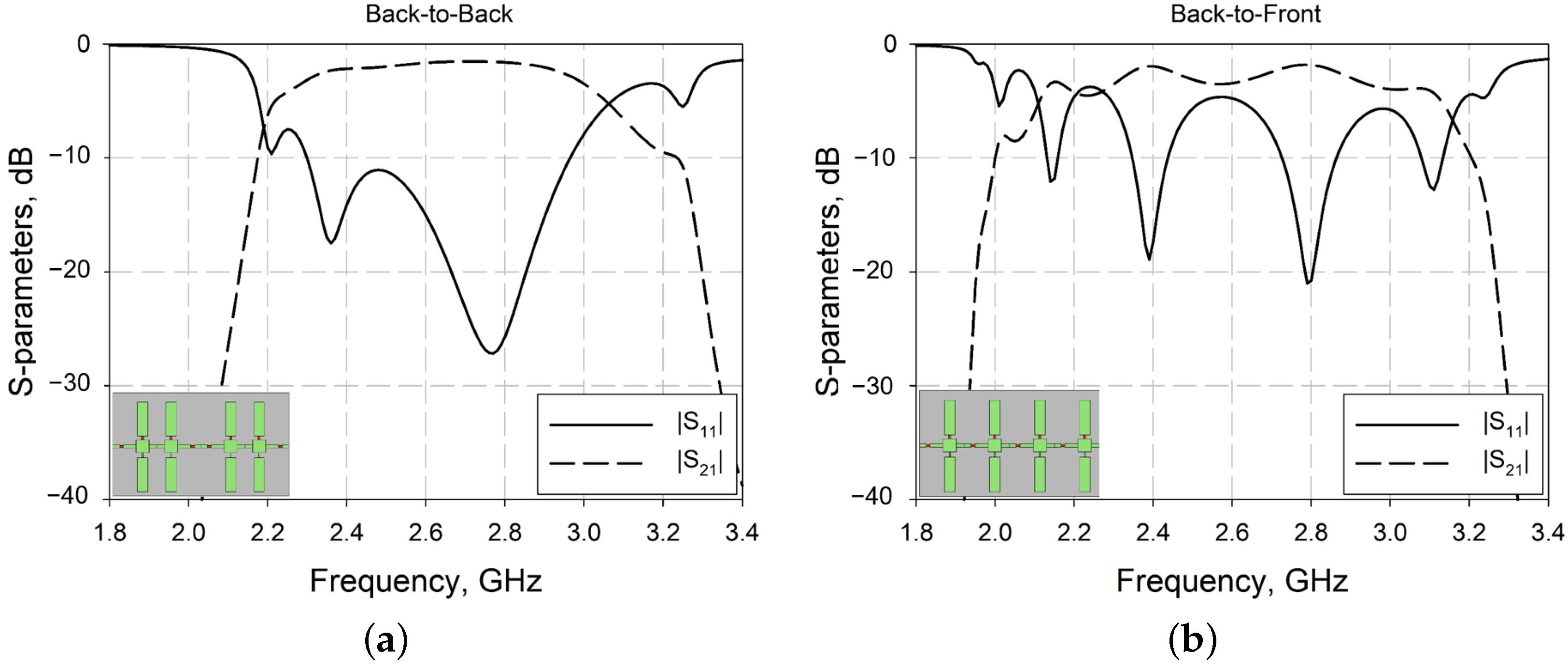
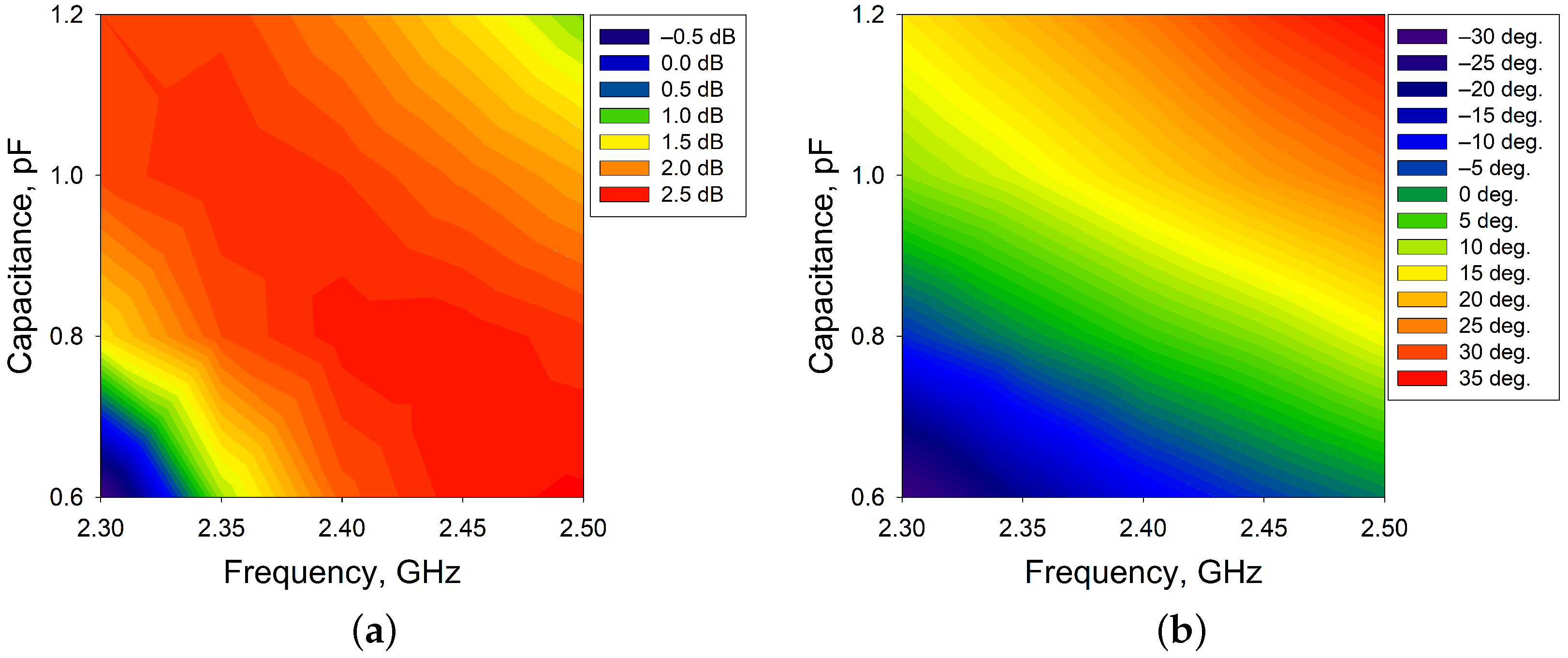
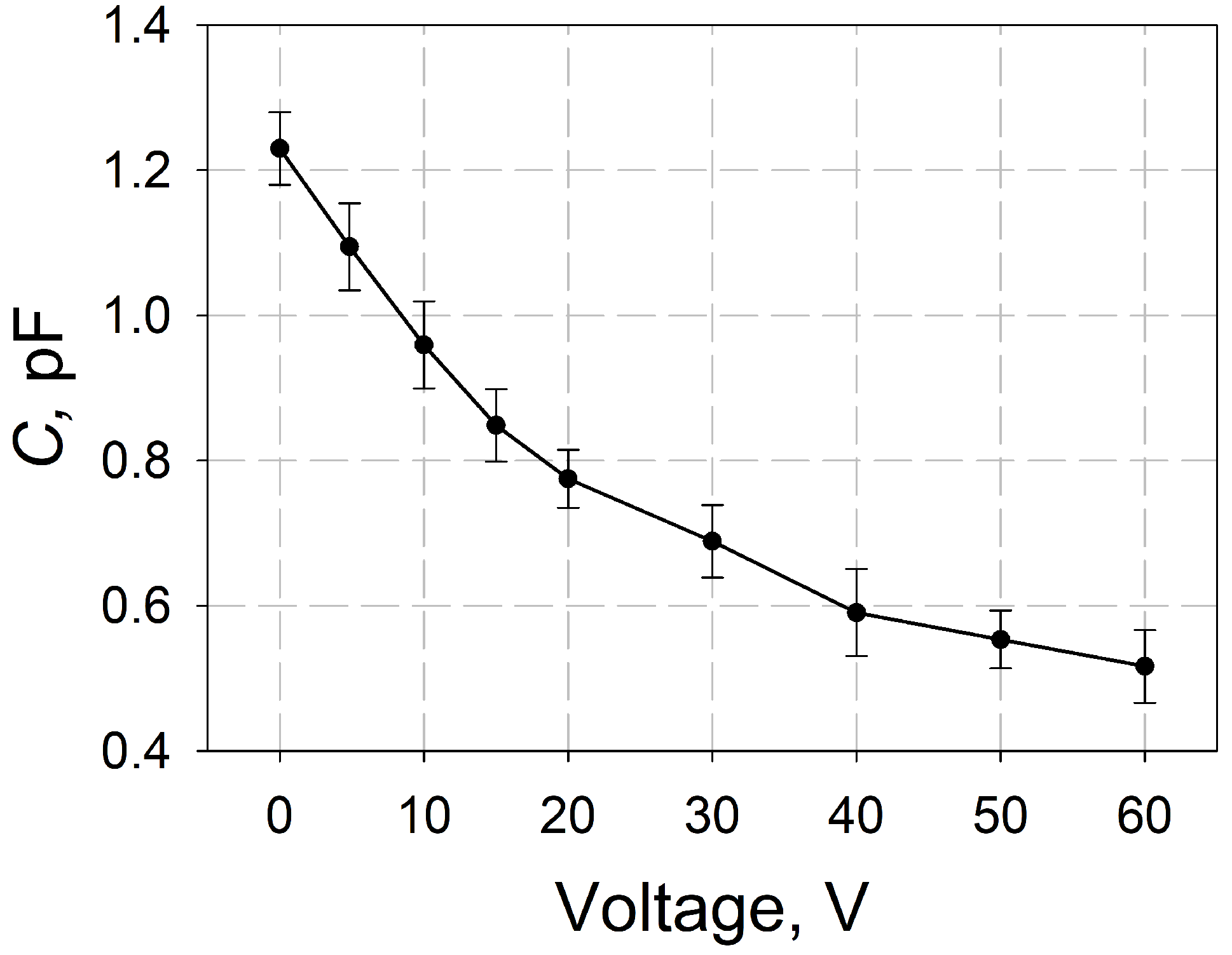
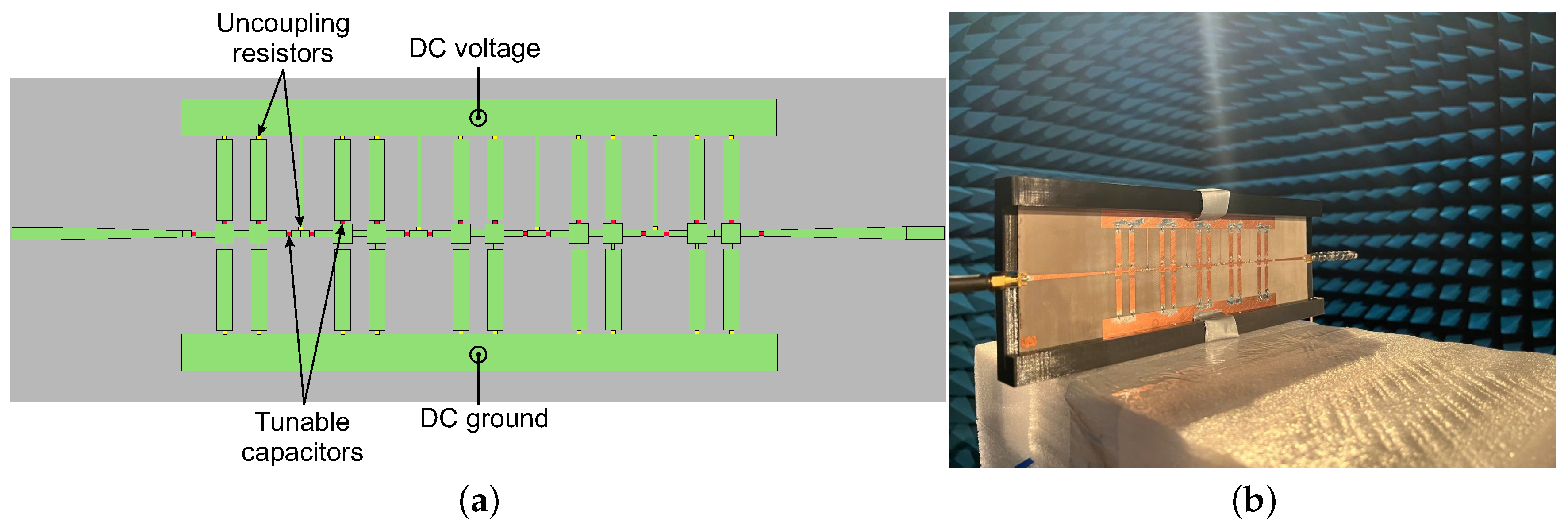

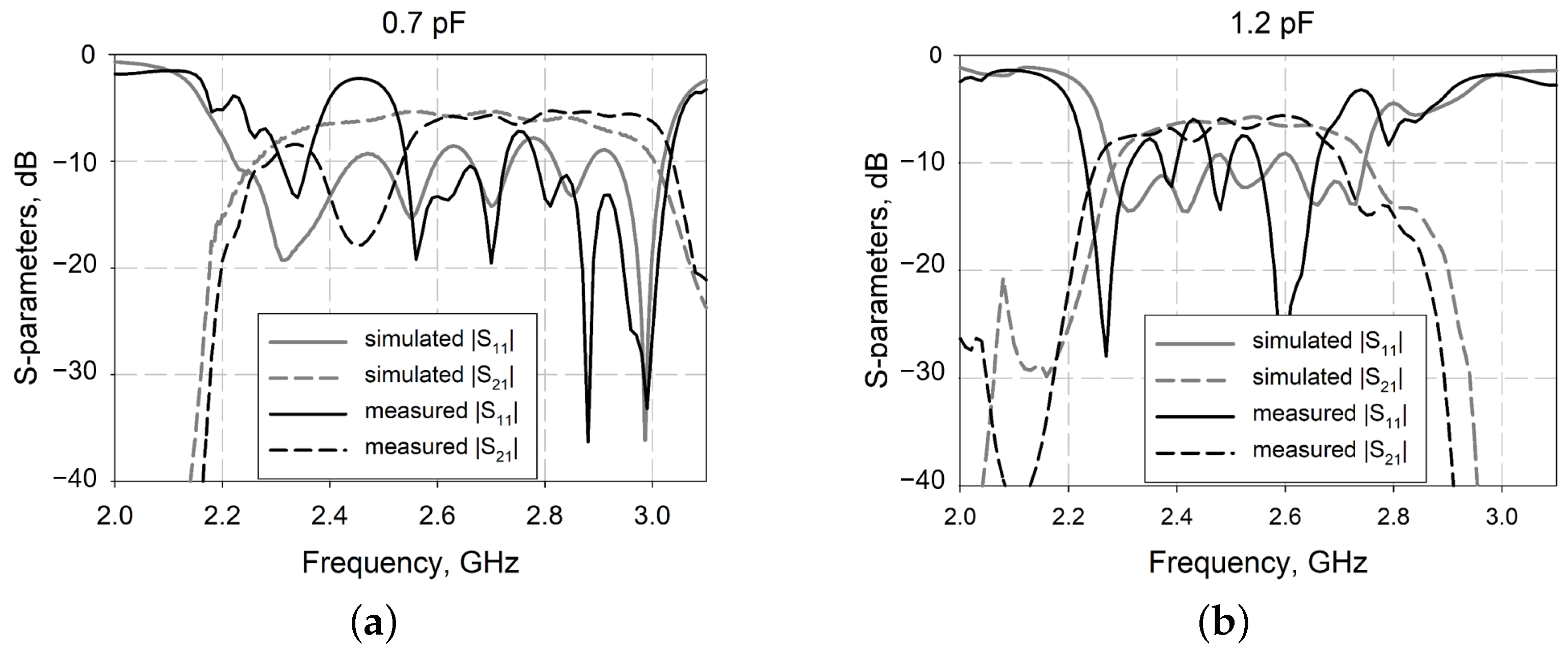
| , nH | , nH | , nH | , nH | , nH | , pF |
|---|---|---|---|---|---|
| 3.4 | 0.7 | 0.31 | 8.8 | 3.5 | 1.1 |
| , mm | , mm | , mm | , mm | , mm | , mm | , mm | , mm | |
|---|---|---|---|---|---|---|---|---|
| 2.5 | 5 | 2 | 1.8 | 1.32 | 0.42 | 5 | 21 | 4 |
Disclaimer/Publisher’s Note: The statements, opinions and data contained in all publications are solely those of the individual author(s) and contributor(s) and not of MDPI and/or the editor(s). MDPI and/or the editor(s) disclaim responsibility for any injury to people or property resulting from any ideas, methods, instructions or products referred to in the content. |
© 2024 by the authors. Licensee MDPI, Basel, Switzerland. This article is an open access article distributed under the terms and conditions of the Creative Commons Attribution (CC BY) license (https://creativecommons.org/licenses/by/4.0/).
Share and Cite
Platonov, R.; Altynnikov, A.; Komlev, A.; Tumarkin, A.; Kozyrev, A. Composite Right/Left-Handed Leaky-Wave Antenna with Electrical Beam Scanning Using Thin-Film Ferroelectric Capacitors. Coatings 2024, 14, 143. https://doi.org/10.3390/coatings14010143
Platonov R, Altynnikov A, Komlev A, Tumarkin A, Kozyrev A. Composite Right/Left-Handed Leaky-Wave Antenna with Electrical Beam Scanning Using Thin-Film Ferroelectric Capacitors. Coatings. 2024; 14(1):143. https://doi.org/10.3390/coatings14010143
Chicago/Turabian StylePlatonov, Roman, Andrey Altynnikov, Andrey Komlev, Andrey Tumarkin, and Andrey Kozyrev. 2024. "Composite Right/Left-Handed Leaky-Wave Antenna with Electrical Beam Scanning Using Thin-Film Ferroelectric Capacitors" Coatings 14, no. 1: 143. https://doi.org/10.3390/coatings14010143
APA StylePlatonov, R., Altynnikov, A., Komlev, A., Tumarkin, A., & Kozyrev, A. (2024). Composite Right/Left-Handed Leaky-Wave Antenna with Electrical Beam Scanning Using Thin-Film Ferroelectric Capacitors. Coatings, 14(1), 143. https://doi.org/10.3390/coatings14010143







